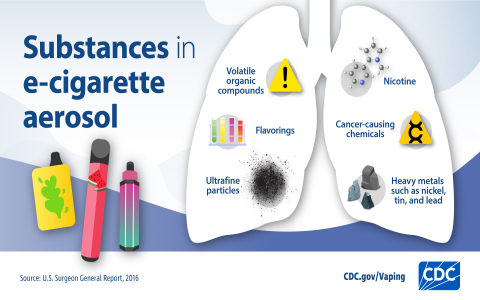What are Electronic Cigarettes?
Electronic cigarettes, also known as e-cigarettes, vapes, or electronic nicotine delivery systems (ENDS), are battery-operated devices that people use to inhale an aerosol. This aerosol typically contains nicotine, flavorings, and other chemicals. They are designed to simulate the act of smoking tobacco cigarettes without burning tobacco.
How Do They Work?
E-cigarettes function by heating a liquid solution, commonly called e-liquid or vape juice, to produce an aerosol (often referred to as vapor). This aerosol is then inhaled by the user. A typical device comprises a battery, a heating element (atomizer), and a cartridge or tank to store the e-liquid.

Key Components and E-liquid Constituents
The composition of e-liquids varies significantly, but generally includes several primary ingredients:
- Nicotine: Most e-cigarettes contain nicotine, the same highly addictive substance found in traditional cigarettes. Nicotine concentrations can differ widely among products.
- Flavorings: A vast array of flavorings, such as fruit, candy, and mint, are utilized in e-liquids. Certain flavoring chemicals have been linked to respiratory problems when inhaled.
- Propylene Glycol (PG) and Vegetable Glycerin (VG): These are common base liquids that generate the aerosol. While generally recognized as safe for ingestion, the long-term effects of inhaling them are not fully understood.
- Other Chemicals: E-cigarette aerosol can contain other potentially harmful substances. These may include volatile organic compounds (VOCs), fine particulate matter, heavy metals (e.g., nickel, tin, lead), and carcinogens.
Health Implications
Although often marketed as a safer alternative to smoking, e-cigarettes are not harmless and present several health risks:
- Nicotine Addiction and Development: Nicotine is profoundly addictive. Exposure during adolescence can impair brain development, which continues into the early to mid-20s, potentially impacting attention, learning, and mood.
- Aerosol Contents: The aerosol inhaled from e-cigarettes is not merely water vapor. It can contain harmful and potentially harmful substances, including irritants, toxins, and carcinogens.
- Lung Health: E-cigarette use has been associated with various respiratory issues. Severe lung injury, known as e-cigarette or vaping product use-associated lung injury (EVALI), has been reported, primarily linked to THC-containing products adulterated with vitamin E acetate, though other substances may also contribute.
- Cardiovascular Effects: Emerging evidence suggests that e-cigarette use may have adverse effects on heart health, although more extensive long-term research is necessary.
Comparison with Combustible Cigarettes
E-cigarettes generally expose users to fewer toxic chemicals than combustible tobacco cigarettes. For adult smokers who completely switch from traditional cigarettes to e-cigarettes, they might represent a less harmful option. However, e-cigarettes still deliver harmful substances, and their long-term health effects are not yet fully established. Dual use (smoking both e-cigarettes and traditional cigarettes) does not reduce health risks and may potentially increase them.
Use Among Youth
There has been a notable surge in e-cigarette use among youth and young adults. Appealing flavors, targeted marketing strategies, and the perception of e-cigarettes as less harmful than traditional cigarettes contribute to their popularity within this demographic. Early nicotine exposure can lead to addiction and may increase the likelihood of future smoking of combustible cigarettes.
Regulatory Landscape
Regulations for e-cigarettes vary extensively across countries and regions. These can encompass restrictions on sales to minors, marketing practices, flavor bans, nicotine concentration limits, and product standards. The regulatory environment is continuously evolving as more research data becomes available.
E-cigarettes for Smoking Cessation
The utility of e-cigarettes as a smoking cessation tool is a subject of ongoing debate and scientific investigation. Some studies indicate they may assist certain adult smokers in quitting combustible cigarettes. However, other evidence is inconclusive or demonstrates limited effectiveness compared to established, evidence-based cessation methods. Health authorities generally recommend proven cessation aids and counseling as first-line treatments for nicotine addiction.









